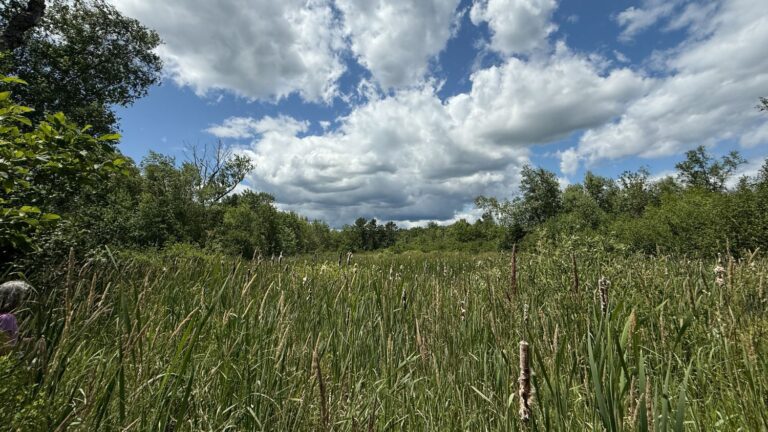Maine has no statewide data on pollen, despite the reality that the fine plant powder causes congestion, sneezing and itchy eyes for thousands of Mainers each year. But new efforts are underway to establish a monitoring system that could eventually send pollen advisory warnings to the public.
About 8% of adults in the northeast United States experienced hay fever in 2018 but there isn’t any Maine-specific data, said Rebecca Lincoln, a toxicologist with the Maine Center for Disease Control and Prevention.

“We don’t know anything about pollen levels in Maine,” Lincoln said. “We can’t even say how people’s allergies are driven by pollen in the state (or) how those exposures are changing over time. And that means we can’t give people good advice on how to protect themselves from experiencing health effects because of exposure to pollen.”
It is important to collect data on pollen, state officials say, because allergies are a quality-of-life problem for a large portion of the population. And Maine has one of the highest rates of asthma in the country: 12% compared to 9% nationally.
The problem is expected to grow with the warming climate. A study published this year found that pollen seasons in North America have lengthened by 20 days and pollen concentrations have increased 21% since 1990 due to climate change.
There have been a few testing sites in Maine, including at Eastern Maine Medical Center in Bangor and the Aroostook Band of Micmacs in Presque Isle. But testing isn’t sufficiently widespread, nor publicly available, to represent the entire state.
There’s little data because collection is meticulous, time-consuming work. Lincoln called the process “just painful.”

The most common collection method captures pollen with a sticky substance on one-inch glass rods that hang from a spinning circular disk, said Andy Johnson, director of the Air Quality Assessment Division at the state Department of Environmental Protection. After 24 hours, the rods are collected and brought to a lab where the particles are manually counted and identified.
The primary allergens in Maine are likely from birch, oak, maple and pine trees, Johnson said, but it’s hard to say for sure without sufficient data.
Pollen monitoring may be in Maine’s future
A new monitoring method under review could dramatically streamline the process. The system continuously draws air into a machine that has sticky tape on a roll. Every minute, a camera takes a high resolution photo of all the particles captured on the tape. Then that image is sent electronically to a computer that uses artificial intelligence to identify the pollen particles.
An ongoing study is testing the technology in three sites across the country to see if it’s accurate. Johnson said results are expected over the winter.
While there’s currently no funding for monitoring equipment, the Maine CDC last month received a federal grant to evaluate potential monitoring sites. Maine CDC and DEP are working together to create a stakeholder group that will identify the locations.
The goal is to make the data publicly available, with advisories for people with allergies, like an air quality index warning, Lincoln said.
The federal funding is part of a renewed grant related to the health impacts of climate change.
About a third of the grant, which is $300,000 annually for five years, will be related to pollen.
Maine CDC will use the rest of the grant to complete work on a resource handbook for local governments to prepare for extreme heat and cold weather events. The guidebook will include resources on how to recognize heat and cold illnesses, and who might be most vulnerable.
Maine has been continuously funded under this grant since the first cycle in 2010. The initial focus was two-fold: Prepare for extreme weather due to changing climate, and address tickborne diseases such as Lyme.
Under Gov. Paul LePage’s administration, however, the focus was shifted away from extreme weather and centered solely on Lyme disease.
Lincoln said they weren’t explicitly told to back off anything related to climate change, but the LePage administration was “not supportive of the grant being focused on anything but tick-borne diseases, sort of Lyme disease specifically.”
There were other programs unrelated to climate change that also were halted, she said.
“We were in a period of economic downturn (and) shrinking state government,” Lincoln said. “There was really careful scrutiny happening of all the federal funding streams that were coming in, as well as state-run programs and state budgetary programs.”
But the shift “absolutely” hindered work the Maine CDC planned around preparing for extreme weather.
In recent years, under Gov. Janet Mills, Lincoln said they’ve renewed work related to climate change.
Mills, a Democrat, and LePage, a Republican, are expected to face each other in the 2022 gubernatorial race. Although Mills hasn’t formally announced her re-election campaign, she has been fundraising since March. LePage launched his campaign last month.
Asked if a change in the administration could threaten the future of the grant work, Lincoln said: “I would hope not.”
“Our work always is going to have to be in some way responsive to the administration that we’re under at any given time,” Lincoln continued. “That’s just the way state government works.”
Providing information at the local level, through the resource handbook, could alleviate potential turmoil from a new administration, she said.
“If we can use this grant to put something together quickly that communities can use to start thinking through these (climate change) problems themselves and identifying potential solutions … the potential loss of funding for whatever reason at the state level would be less harmful to the work than it might have been in previous years.”







